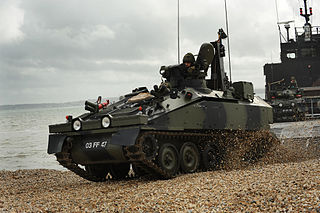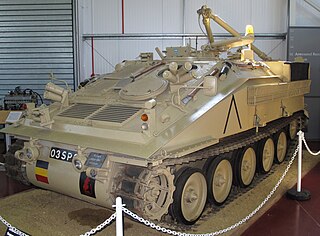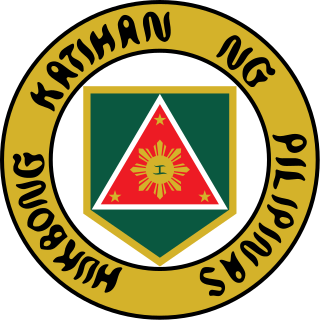A division is a large military unit or formation, usually consisting of between 10,000 and 25,000 soldiers. In most armies, a division is composed of several regiments or brigades; in turn, several divisions typically make up a corps.

The Combat Vehicle Reconnaissance (Tracked) (CVR(T)) is a family of armoured fighting vehicles (AFVs) developed in the 1960s and is in service with the British Army and others throughout the world. They are small, highly mobile, air-transportable armoured vehicles, originally designed to replace the Alvis Saladin armoured car.

The FV101 Scorpion is a British armoured reconnaissance vehicle and light tank. It was the lead vehicle and the fire support type in the Combat Vehicle Reconnaissance (Tracked), CVR(T), family of seven armoured vehicles. Manufactured by Alvis, it was introduced into service with the British Army in 1973 and was withdrawn in 1994. More than 3,000 were produced and used as a reconnaissance vehicle or a light tank.

FV103 Spartan is a tracked armoured personnel carrier. It was developed for the British Army as the APC variant of the Combat Vehicle Reconnaissance (Tracked) family. The vehicle can carry up to seven personnel, including three crew members. Armed with a single machine gun, it is almost indistinguishable from the FV102 Striker in external appearance.

FV105 Sultan was a British command and control vehicle based on the CVR(T) platform. It has a higher roof than the armoured personnel carrier variants, providing a more comfortable "office space" inside. Sultan entered service in 1978. It is no longer used by British Armed Forces.

FV106 Samson was a British Army armoured recovery vehicle, one of the CVR(T) family. The main role of this vehicle was to recover the CVR(T) family of vehicles, but could also recover other light tracked vehicles such as the FV430 series.

The FV107 Scimitar is an armoured tracked military reconnaissance vehicle formerly used by the British Army, until it was retired from active service in April 2023. It was manufactured by Alvis in Coventry. It is very similar to the FV101 Scorpion, but mounts a high-velocity 30 mm L21 RARDEN cannon instead of a low-velocity 76 mm gun. It was issued to Royal Armoured Corps armoured regiments in the reconnaissance role. Each regiment originally had a close reconnaissance squadron of five troops, each containing eight FV107 Scimitars. Each Main Battle Tank Regiment also employed eight Scimitars in the close reconnaissance role.

The Amphibious Vehicle, Tracked (LVT) is an amphibious warfare vehicle and amphibious landing craft, introduced by the United States Navy and United States Marine Corps. The United States Army, Canadian Army and British Army used several LVT models during World War II, and referred to those vehicles as "Landing Vehicle, Tracked."

The Alvis Stormer is a military armoured vehicle manufactured by the British company Alvis Vickers, now BAE Systems Land & Armaments.
The Formation Reconnaissance Regiment is a fighting unit provided by the Royal Armoured Corps or Household Cavalry.

The ASCOD armoured fighting vehicle family is the product of a cooperation agreement between Austrian Steyr-Daimler-Puch AG and Spanish General Dynamics Santa Bárbara Sistemas. Both companies are now divisions of a unit of General Dynamics. The ASCOD family includes the LT 105 light tank equipped with a 105 mm gun, a surface-to-air missile launcher, an anti-tank guided missile launcher, mortar carrier, R&R vehicle, command-and-control vehicle, ambulance, artillery observer, and the AIFV model.

The Cadillac Gage Commando, frequently denoted as the M706 in U.S. military service, is an American armored car designed to be amphibious. It was engineered by Cadillac Gage specifically for the United States Military Police Corps during the Vietnam War as an armed convoy escort vehicle. The Commando was one of the first vehicles to combine the traditionally separate roles of an armored personnel carrier and a conventional armored car, much like the Soviet BTR-40. Its notable height, amphibious capability, and waterproofed engine allowed American crews to fight effectively in the jungles of Vietnam by observing their opponents over thick vegetation and fording the country's deep rivers.

ACV-15 is the designation of an amphibious Infantry fighting vehicle family developed by the Turkish defense company FNSS Savunma Sistemleri A.Ş. This vehicle is also manufactured by DRB-HICOM Defence Technologies (DefTech) in Malaysia. The design is an attempt to combine the capabilities of an infantry fighting vehicle (IFV) and an armoured personnel carrier (APC). The ACV-15 is based on the American Advanced Infantry Fighting Vehicle, which in turn is based on the American M113A1 armored personnel carrier.

The Cadillac Gage LAV-300, originally named the V-300, is a family of American light armored vehicles (LAVs) including up to 15 configurations. It was originally created and designed by CG as a private venture project.

The Philippine Army (PA) is the main, oldest and largest branch of the Armed Forces of the Philippines (AFP), responsible for ground warfare and as of 2021 had an estimated strength of 143,100 soldiers The service branch was established on December 21, 1935, as the Philippine Commonwealth Army. The Philippine Army has engaged in many conflicts including the ongoing Communist rebellion in the Philippines, the Moro conflict and, alongside other national military forces, in conflicts of international scope.

The Simba is a wheeled armoured personnel carrier designed by GKN Sankey. It is currently in service with the Philippine Army.

The Alvis Tactica is a 4x4 or 6x6 wheeled military vehicle produced by GKN Defense, Alvis plc and later by BAE Systems Land Systems. The vehicle was designed by Glover Webb and introduced in 1988. It comes in a number of variants including APC and Internal Security and Riot Control. The platform is no longer produced by BAE Systems.

The Sri Lanka Armoured Corps (SLAC) provides the armour capability of the Sri Lanka Army, with vehicles such as the T-55AM2 main battle tank; the BMP infantry fighting vehicle; and the BTR-80 and WZ551 armoured personnel carriers. It comprises five regular armoured regiments, a volunteer regiment, and a regimental band. It has an independent Armoured Brigade and is headquartered at Rock House Army Camp, Colombo.

The VBTP-MR Guarani is a 6×6 armoured personnel carrier developed by Iveco and the Brazilian Army as part of its "Urutu-III" modernization program aimed to replace all EE-11 Urutu by 2015. The 8×8 version of the VBTP-MR is the base of Iveco's Superav armoured personnel carrier. Other Brazilian companies also participated in the program, such as IMBEL (Communications), Elbit (Armaments), Usiminas and Villares.

The Philippine Army Museum is a military museum located within the premises of Fort Bonifacio in Taguig, Philippines.



















